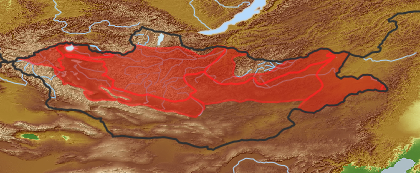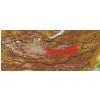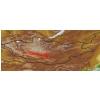| Class: | angiosperms |
| Order: | Poales |
| Family: | Typhaceae |
| Genus: | Typha |
| Scientific name: | Typha laxmannii Lepech. |
| Name acc. to: | Gubanov 1996 |
| Herbar: | list records  |
| Description: | Leaves up to 5 mm broad. Staminate and pistillate part of inflorescence separated; pistillate inflorescences often ovoid, 2-10 cm long. |
| Link to Flora of China: | http://www.efloras.org/browse.aspx?flora_id=2&name_str=Typha+laxmannii |
| open map in a new window |  |
| Habitat: | Waterside shallow places of large and small lakes, old river beds and streams (Grubov 2001). |
| Habit (i)general appearance of a plant | |
| Growth form: (i)Herb, shrub, tree or climber. | herb (i)Herbaceous, erect plant, up to 2m high, mostly with a leafy shoot; if perennial, shoots die to the ground each season, shoots are not woody
example: Artemisia pectinata   inherited by family Typhaceae: herb inherited by family Typhaceae: herb
perennial (i)Living for several to many years, as opposed to annual and biennial  inherited by genus Typha: perennial inherited by genus Typha: perennial
|
| Special growth forms or habits: | creeper (i)Low, mat-forming herbaceous plant, growing along the surface of the ground or just beneath the surface with rhizomes like a mat
example: Potentilla anserina, Lycopodium annotinum   inherited by genus Typha: creeper inherited by genus Typha: creeper
|
| Parasite status: (i)Is the plant a half- or full parasite? | no parasite/saprophyte (i)Plant fully autonomous, leaves with chlorophyll
example: Most plants, Ranunculus  inherited by family Typhaceae: no parasite/saprophyte inherited by family Typhaceae: no parasite/saprophyte
|
| Water or terrestrial plant: (i)Where do the plants grow? | water or swamp plant  inherited by family Typhaceae: water or swamp plant inherited by family Typhaceae: water or swamp plant
plants in swamps, marshes or bogs, leaves rising above water (i)Semiaquatic; plant terrestrial, but restricted to wet or moistured environments with ground water at or near the surface
example: Phragmites communis  inherited by genus Typha: plants in swamps, marshes or bogs, leaves rising above water inherited by genus Typha: plants in swamps, marshes or bogs, leaves rising above water
|
| Leaf (i)expanded, usually photosynthetic organ of a plant (including phylloclades) | |
| Leaf development: (i)Structure and development of leaves. | flattened blade (i)Cross-section of lamina flat, plain  inherited by genus Typha: flattened blade inherited by genus Typha: flattened blade
common leaf (i)Green, often divided in blade and petiole
example: Cotoneaster  inherited by genus Typha: common leaf inherited by genus Typha: common leaf
with green leaves (i)Plant with green leaves  inherited by genus Typha: with green leaves inherited by genus Typha: with green leaves
|
| Leaf arrangement: (i)Arrangement of leaves at the stem. | alternate (i)One leaf per node; distiche: arranged in two vertical rows, equitant
example: Phragmites    inherited by genus Typha: alternate inherited by genus Typha: alternate
|
| Simple or divided leaves: (i)Are the leaves simple or completely divided in several parts? Blade of the leaf entire or (more or less) deeply dissected. Attention: There are various appearances of the leaf margin (from entire to toothed and lobed). Here, we ignore this and ask only for dissections that separate the leaf for more than one third of its length or width, whatever is smaller. Sometimes, it is difficult to tell apart compound leaves from a shoot system with simple leaves: look for stipulae and/or axillary buds at the ground of the leaves: if only some possess these structures, the others are most likely leaflets of a compound leaf. | simple (i)Non-divided leaf, but margin may be incised nearly to the ground   inherited by order Poales: simple inherited by order Poales: simple
|
| Shape of blade: (i)Easy for simple leaves. In compound leaves use the general shape of leaflet. Always check the ground for largest leaves of a plant. To be worked out: how to handle pinnate leaves? | linear incl.grasslike or oblong (i)Leaves more than two times longer than broad with more or less parallel margins; see character: stipule for ligula
example: Dracocephalum ruyschiana, Poaceae, Scutellaria scordifolia, Pinus   inherited by genus Typha: linear incl.grasslike or oblong inherited by genus Typha: linear incl.grasslike or oblong
|
| Length of leaves: (i)How long is the leaf, be carefull in compound leaves, measure the complete leaf. | more than 50 mm  inherited by genus Typha: inherited by genus Typha:
|
| Leaf apex: (i)Appearance of the tip of leaf resp. leaflets in compound leaves. | acuminate (i)Gradually tapering to a (sharp) point
example: Populus laurifolia?   inherited by genus Typha: acuminate inherited by genus Typha: acuminate
|
| Leaf margin: (i)Structure of leaf margin (or that of a leaflet in case of compound leaves). Attention: Here we ask for the leaf margin, defined as all those dissections that separate the leaf for less than one third of its length or width, whatever is smaller. To be worked out: how to handle margin of pinnate leaves? | entire (i)Plain margin, not toothed
example: Iris   inherited by order Poales: entire inherited by order Poales: entire
|
| Petiole: (i)Leaf divided into stalk (petiole) and blade. | without (i)Leaves without petiole (stalk), sessile
example: Poaceae, Iris   inherited by genus Typha: without inherited by genus Typha: without
surrounding stem (i)Base ensheathing the shoot
example: Iris, Poaceae  inherited by genus Typha: surrounding stem inherited by genus Typha: surrounding stem
|
| Stipule: (i)Leaflets at the base of the petiole, these are smaller and of different shape. | none (i)Without stipules
example: Euphorbia, Ericaceae s.l.  inherited by genus Typha: none inherited by genus Typha: none
|
| Leaf colour upper side: (i)Shades of green on the leaf, upper side. | green (i)Clear green
example: Tribulus terrestris  inherited by genus Typha: green inherited by genus Typha: green
|
| Leaf colour lower side: (i)Shades of green on the leaf, lower side. | green (i)Clear green, in most species
example: Angelica decurrens  inherited by genus Typha: green inherited by genus Typha: green
|
| Leaf veination: (i)Arrangement of the main veins of a leaf. | parallel (i)Most veins arranged parallel to the length of leaf, mostly no pronounced main vein (usually in elongate to linear leaves)
example: Most Monocotyledonae, Plantago, Veratrum, a lot of Caryophyllaceae looks like that.   inherited by order Poales: parallel inherited by order Poales: parallel
|
| Flower (i)reproductive portion of the plant, consisting of sepals, petals, stamens, and pistils | |
| Flower appearance and pollination: (i)General appearance of the flower. | not attractive, wind-pollinated or some water plants (i)Small, colourless or green flowers
example: Betula, grasslike plants: Carex, Setaria, Juncus  inherited by family Typhaceae: not attractive, wind-pollinated or some water plants inherited by family Typhaceae: not attractive, wind-pollinated or some water plants
|
| Perianth arrangement: (i)Attention: in some plants, flowers may be dimorphic in different ways (dioecious or gynodioecious). If flowers vary, record the characters of the most showy flowers. | absent or strongly reduced (i)No perianth leaves ensheathing stamen and/or carpels
example: Callitriche   inherited by genus Typha: absent or strongly reduced inherited by genus Typha: absent or strongly reduced
|
| Diameter of flower: (i)Diameter of flower or flower head. | to 5 mm (i)
example: Aruncus  inherited by genus Typha: inherited by genus Typha:
|
| Sepal number: (i)Number of sepal leaves (outer perianth leaves, calyx leaves, mostly greenish). Attention, this character applies only for flowers separated in sepals and petals, thus excluding most monocots. Be aware of the bracts (involucral leaves) of Asteraceae flowerheads, do not qualify these as sepals! Be also aware in Rosaceae is often an epicalyx developed, in this case count all parts. | none or rudimentary (i)Hardly visible or absent, since perianth uniform
example: All monocots with uniform perianth, many Asteraceae and Apiaceae  inherited by genus Typha: none or rudimentary inherited by genus Typha: none or rudimentary
|
| Petal / Tepal number: (i)Number of petal leaves (inner perianth leaves, usually coloured). | none or reduced (i)But green sepals may exist
example: Thalictrum  inherited by genus Typha: none or reduced inherited by genus Typha: none or reduced
|
| Spur: (i)A hollow, slender, sac-like appendage of the perianth leaves, storing nectar. | no spur (i)Flower without appendage
example: Peganum  inherited by genus Typha: no spur inherited by genus Typha: no spur
|
| Stamen fusion: (i)To which degree are the stamens fused? Attention: Whereas the pollen sacs itself are often free., their stalks (filaments) may be fused. Here, we count them as fused if they are together over at least one thirth of their length. | fused with each other (i)All or most stamens fused with each other to a tube-like structure
example: Caragana, Petasites  inherited by genus Typha: fused with each other inherited by genus Typha: fused with each other
|
| Carpel number: (i)Number of carpels (carpel: forming a simple pistil or part of a compound pistil, modified leaf). | 2  inherited by genus Typha: 2 inherited by genus Typha: 2
3  inherited by genus Typha: 3 inherited by genus Typha: 3
|
| Ovary position: (i)For entirely or partly fused carpels, describe their position in relation to the insertion point of perianth leaves (best done by doing a longitudinal section of a flower). | superior (hypogynous) (i)Base of carpels attached above insertion point of perianth leaves, carpels free or fused
example: Delphinium, Anemone    inherited by genus Typha: superior (hypogynous) inherited by genus Typha: superior (hypogynous)
|
| Sex: (i)Distribution of male and female organs among flowers, only most commonly cases. | unisexual (i)
example: Rhodiola  inherited by genus Typha: unisexual inherited by genus Typha: unisexual
monoecious (i)Male and female flowers at the same plant
example: Xanthium, Larix, Atriplex  inherited by genus Typha: monoecious inherited by genus Typha: monoecious
|
| Inflorescence (i)flowering part of a plant, describes the arrangement of the flowers on the flowering axis | |
| Inflorescence: (i)Structure of the inflorescence. | Flowers in inflorescence (i)No solitary flowers  inherited by genus Typha: Flowers in inflorescence inherited by genus Typha: Flowers in inflorescence
Simple inflorescences (i)Flowers sessile on a main shoot or on short to long not branched side shoots
example: Polygonum bistorta    inherited by genus Typha: Simple inflorescences inherited by genus Typha: Simple inflorescences
|
| Appearance: (i)Outer look of the inflorescence. | terminal (i)Inflorescence is the highest point of the plant and may consist of a single flower only
example: Cypripedium, Rhaponticum, Ligularia sibirica, Echinops  inherited by genus Typha: terminal inherited by genus Typha: terminal
|
| Inflorescence type: (i)Types of inflorescence. Attention: We here ask for the botanical nomenclature of inflorescences, which is sufficiently complicated. Tick only, if you are certain, or tick all inflorescence types that appear similar of these of the plant in question. | spike (spadix) (i)All flowers sessile and crowded along a main axis, there may be several spikes on a shoot; sometimes axis thickened (spadix)
example: Plantago, Carex vesicaria, Vicia, Typha (spadix)    inherited by genus Typha: spike (spadix) inherited by genus Typha: spike (spadix)
|
| Fruit (i)the seed bearing organ, with or without adnate parts; a ripened ovary and any other structures which are attached and ripen with it. Aggregate fruits are handled like simple fruits for determination. | |
| Consistency: (i)Fleshy fruits or dry fruits, see dispersal adaptations for further classification. | dry (i)With a dry outer shell, no fleshy parts, but seed (embryo) could be edible  inherited by genus Typha: dry inherited by genus Typha: dry
|
| Size of fruit: (i)Size of the fruit including appendage. | to 5 mm (i)
example: Halerpestes: many folicles forming dry nutlets  inherited by genus Typha: inherited by genus Typha:
|
| Dispersal: (i)Appearance of fruit or seed (if single) and adaptations to dispersal. | Flying (wind dispersed) (i)Fruits or seeds with appendages to fly
example: Taraxacum, Atraphaxis, Pulsatilla  inherited by genus Typha: Flying (wind dispersed) inherited by genus Typha: Flying (wind dispersed)
|
| Hairs | |
| Has hairs?: | no hairs, glabrous  inherited by genus Typha: no hairs, glabrous inherited by genus Typha: no hairs, glabrous
|
| Shoot/Stem (i)a young stem or branch | |
| Cross section: (i)Shape of the cross section of a stem or shoot (look at first to second year shoots). | round (i)Stem or shoot round
example: Allium  inherited by genus Typha: round inherited by genus Typha: round
|
| Spines, thorns or prickles: (i)Shoot with conspicuous spines, thorns or prickles. | absent (i)Stem glabrous or hairy, but never with spines, thornes or prickles
example: Gentiana barbata  inherited by genus Typha: absent inherited by genus Typha: absent
|
| Root / shoot below ground (i)plant part below ground (in most cases), including below ground shoots, without leaves | |
| Root type: (i)Organisation of the roots. | homorhizous (i)Many equal roots
example: Monocotyledonae  inherited by order Poales: homorhizous inherited by order Poales: homorhizous
|
| Runners: (i)Plant must be excavated; shoots, subterranean shoots connected by runners. | long root suckers or rhizomes (i)Plants grow new shoots from roots or subterranean shoots, called rhizomes, these spacing stems apart
example: Hippophae, Artemisia sericea  inherited by genus Typha: long root suckers or rhizomes inherited by genus Typha: long root suckers or rhizomes
|
| Distribution (i)region where the plant is likely to be found | |
| Distribution (Veg. Zones): (i)acc. to Grubov 1952 | Khangai (i)In distribution data often named as '3' 
Mongol-Daurian (i)In distribution data often named as '4' 
Great Khingan (i)In distribution data often named as '5' 
Khobdo (i)In distribution data often named as '6' 
Middle Khalkha (i)In distribution data often named as '8' 
East Mongolia (i)In distribution data often named as '9' 
Depression of Great Lakes (i)In distribution data often named as '10' 
Valley of Lakes (i)In distribution data often named as '11' 
acc. to: Gubanov 1996 |
| Distribution Khangay: (i)acc. Flora Khangaya 1989 | IV
V
|